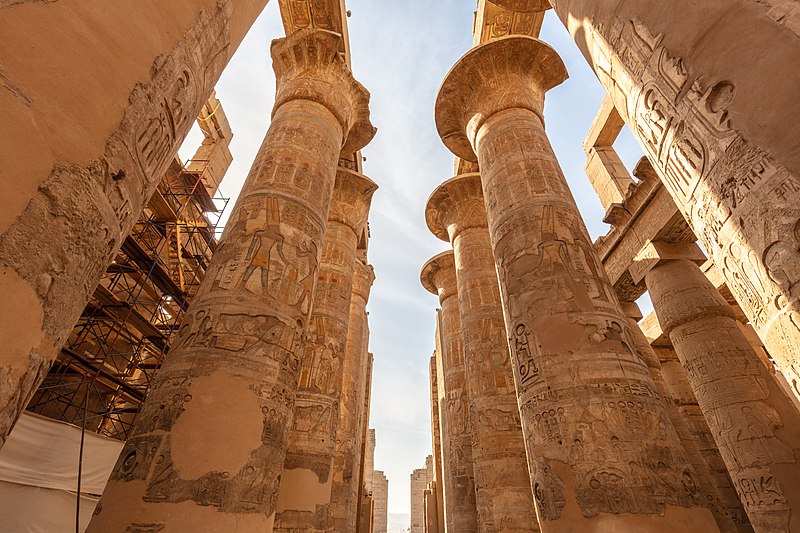Historical Significance of Karnak’s Temple
By: Alana Rehman / Arab America Contributing Writer
Location:
The Karnak temple is situated on the east bank of the Nile River in the southern Egyptian city of Karnak, which is part of the Luxor Governorate. Karnak Temple, commonly known as Karnak, along with the temples, includes chapels, pylons, and an open-air museum.
History of Karnak Temples:
Over more than a thousand years, primarily between the Twelfth and Twentieth Dynasties, the Karnak temple complex at Luxor was built. In its height, it was the largest and most significant religious complex in ancient Egypt. It has four main sections, the largest of which is currently open to the public. “Karnak” is frequently understood to refer solely to the “Precinct of Amun-Re” because the term is the only part that most visitors see. A notable feature of the Temple of Amun-Ra is the enormous Hypostyle Hall built under Seti I’s rule. Public access is restricted to the Precinct of Mut, the Precinct of Montu, and the demolished Temple of Amenhotep IV.
Significance of Karnak Temples:
The Karnak Temple Complex was the heart of the ancient religion during the New Kingdom when Thebes (modern-day Luxor) was the center of authority. The sections of Karnak Temples were named after the Gods that Ancient Egyptians praised. Its magnitude is a reflection of its significance.
Which gods were Amun, Mut, and Khonsu?
- Amun
Amun, also known as Amun-Ra, was a minor Theban deity who gained prominence after Mentuhotep II unified Egypt around 2040 BCE. Amun was the supreme king of the gods because he combined the powers of two older gods, Atum and Ra (the sun god and creator god, respectively), making him both the creator and life preserver. Before any structures were constructed, the Karnak region may have been sacred to Amun, Atum, or Osiris, who were worshiped at Thebes.
Since there is no evidence of domestic homes or markets at the site, it was already designated as holy ground. Instead, religiously themed buildings or royal apartments were built there long after the first temple was built. There was no separation between religious beliefs and daily life in ancient Egypt, so one might think it would be hard to tell a secular building from a holy site. However, this is not always the case. The artwork and inscriptions that have been left on the walls and columns at Karnak clearly indicate that the site has always been religious in nature.
- Mut
Ancient Egyptians worshiped Mut, who was also known as Maut and Mout. The importance of her name is ‘mother,’ and subsequently, she was known as the mother goddess. Some regarded her as the mother of the moon child god khonsu and as the mother of everything in the world by others.
- Khonsu
Khonsu was the ancient Egyptian god of the moon. His name means “traveler,” and he was known as Mut’s son.
The New Kingdom pharaohs used it as a treasury, administrative hub, and palace in addition to its religious significance. It is still regarded as the largest temple complex ever built anywhere in the world to this day.
Interesting Facts about Karnak Temples:
- It is regarded as the world’s largest religious structure or site.
- The Karnak Temple’s 54,000-square-foot Great Hypostyle Hall is large enough to accommodate the Notre Dame Cathedral.
- In order to demonstrate Amon-Ra’s power and significance at the time, more than 8,000 servants and enslaved people were tasked with serving him in Karnak. Additionally, 5,000 statues were erected in his honor.

Karnak continues to fascinate visitors with its size, scope, and the possibilities of how the temple was built in an era without cranes, trucks, or any of the modern technology that one considers so essential in the modern age, just like other ancient sites like Baalbek, Stonehenge, the Great Pyramid, Nemrut Dag, Angkor Wat, and others. The walls and columns of Karnak depict Egypt’s history from the Middle Kingdom through the Fourth Century CE, and as visitors to the site today read the inscriptions, they realize the ancient Egyptian kings’ wish that their great deeds would live on forever by being memorialized in the Temple of Amun at Thebes.
Click here for the blog!








